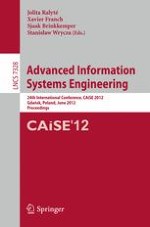This book constitutes the refereed proceedings of the 24th International Conference on Advanced Information Systems Engineering, CAiSE 2012, held in Gdansk, Poland, in June 2012. The 42 revised full papers, 2 full-length invited papers and 4 short tutorial papers, were carefully reviewed and selected from 297 submissions. The contributions have been grouped into the following topical sections: business process model analysis; service and component composition; language and models; system variants and configuration; process mining; ontologies; requirements and goal models; compliance; monitoring and prediction; services; case studies; business process design; feature models and product lines; and human factors.
